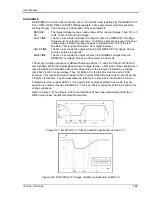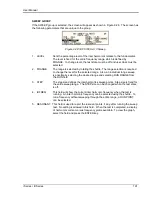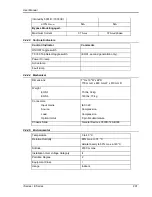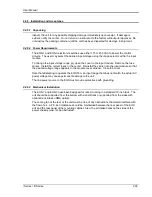
User Manual
i Series / iX Series
197
To run the test, the IEC 61000-4-13 mode must be selected. Refer to paragraph 9.3.4 for
access to the screen. The following conditions have to be met before running the test:
1. Prior to the test, set the nominal voltage, frequency, and phase angle. The frequency must
be 50 or 60 Hz. Function must be set to sine wave.
2. Select EUT CLASS 2, 3 or USER. The default parameters for the USER class are identical
to those for class 3. If USER class is selected, the level and phase parameters can be
edited. For Class 1 EUT‟s, the USER class must be used as well. In this case, set the levels
to those called out in the test document.
3. Set the STATE to ON. It will take a few seconds to initialize data required to perform the
test.
4. If it is desired to run all tests, select ALL form the RUN parameter with the shuttle knob and
press the ENTER key. The tests will run in the following sequence:
FCURVE, OSWING, SWEEP, HARM, IHARM,MCURVE
Note:
The test for class 3 will take about 25 minutes, class 2 slightly less.
5. While the test is running, the ABORT and PAUSE selection is accessible from the RUN field
by rotating the shuttle.
6. If it is desired to run a specific group, the group must be selected from the group screen.
Also, the RUN GROUP must be selected prior to the start of test.
7. To run an individual range, applicable for sweep and individual harmonics only, the desired
range and the RUN RANGE mode must be selected prior to the start of the test. In case the
harmonics group is selected, RUN RANGE will run the harmonics from the second
harmonics to the harmonics number specified by the HARM NO field. See Figure 9-29.
8. To run individual harmonics or individual inter harmonics, set the harmonic number or the
inter harmonics frequency and select RUN POINT prior to running the test.
Summary of Contents for 10001i
Page 2: ......
Page 3: ......
Page 6: ...ii This page intentionally left blank...
Page 38: ...User Manual 24 i Series iX Series Figure 3 5 Rear Panel View for the 3001i 3001iX...
Page 39: ...User Manual i Series iX Series 25 Figure 3 6 Rear Panel View for the 5001i 5001iX...
Page 43: ...User Manual i Series iX Series 29 Figure 3 8 Functional Test Setup...
Page 44: ...User Manual 30 i Series iX Series Figure 3 9 Single Phase 10000 VA System 10001iX i...
Page 46: ...User Manual 32 i Series iX Series Figure 3 11 Single Phase 15000 VA System 15001iX i...
Page 48: ...User Manual 34 i Series iX Series Figure 3 13 Connection With MODE Option...
Page 118: ...User Manual 104 i Series iX Series Figure 5 2 Power Source Module Block Diagram...
Page 121: ...User Manual i Series iX Series 107 Figure 5 3 5001i Internal Layout...
Page 122: ...User Manual 108 i Series iX Series Figure 5 4 Logic Board LED s...
Page 124: ...User Manual 110 i Series iX Series Figure 5 5 AC Power Stage Layout...
Page 125: ...User Manual i Series iX Series 111 Figure 5 6 AC Control Logic Block Diagram...
Page 138: ...User Manual 124 i Series iX Series Figure 6 3 Adjustment Location...
Page 152: ...User Manual 138 i Series iX Series Figure 9 4 Voltage Modulation...
Page 219: ...User Manual i Series iX Series 205 Figure 9 36 Example Connection With 5001iX and EOS 1...
Page 221: ...User Manual i Series iX Series 207 Figure 9 38 15003iX CTS EOS3 LR3...
Page 222: ...User Manual 208 i Series iX Series Figure 9 39 15003iX 3 EOS3...
Page 233: ...User Manual i Series iX Series 219 Figure 9 41 Example Connection With MODE iX...
Page 240: ...User Manual 226 i Series iX Series Figure 9 42 Example Connections With OMNI 1 18i...
Page 241: ...User Manual i Series iX Series 227 Figure 9 43 Example Connections With OMNI 3 18i...
















































